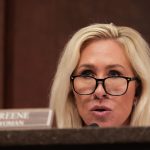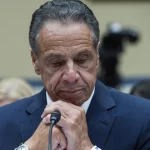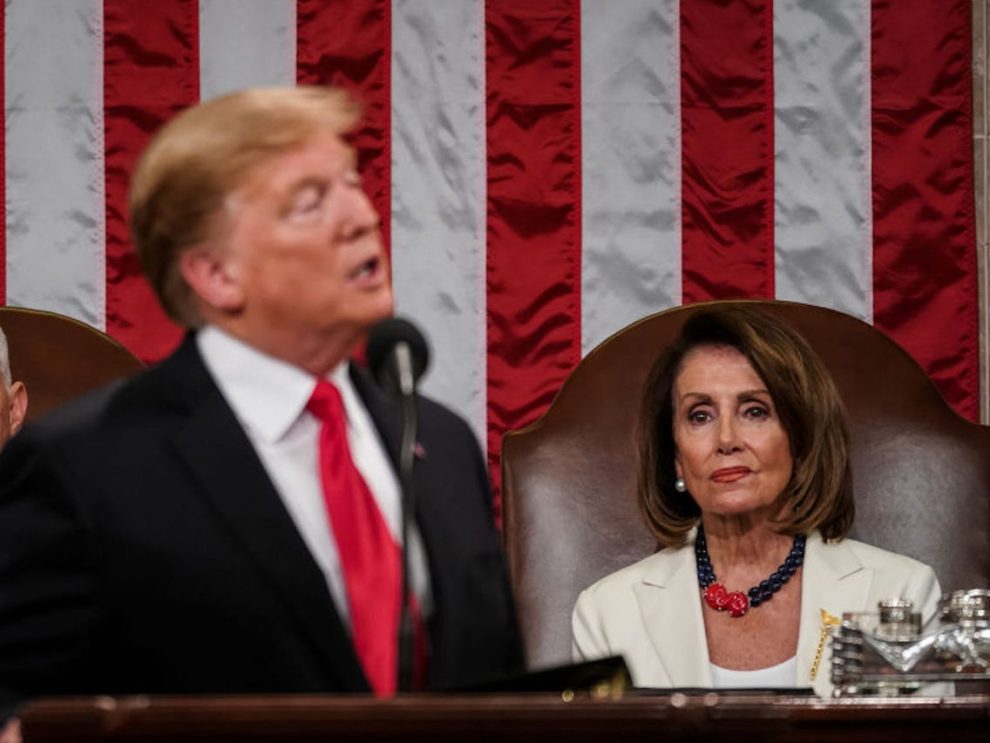Friday marks a full year since Speaker Nancy Pelosi (D-Calif.) and President Trump last spoke to each other.
The anniversary of sorts underscores the historic level of dysfunction and discord between two of the most powerful people in Washington.
Almost every occasion where Pelosi and Trump have crossed paths since Democrats won the House majority in 2018 has shown how much they can’t stand each other, let alone attempt to strike any legislative deals together like other past presidents and Speakers of opposing parties.
Their last extended conversation, during a sit-down meeting at the White House on Oct. 16, 2019, resulted in the two sides unable to agree on whether Trump called Pelosi a “third rate” or “third grade” politician and her telling reporters afterward that “we have to pray for his health.”
Their relations have only worsened since then.
While Pelosi has been able to negotiate bipartisan legislation with White House intermediaries like Treasury Secretary Steven Mnuchin, lawmakers say the open personal animosity between the president and the Speaker is emblematic of the entrenched partisanship in the Trump era.
“It’s a sad commentary on the circumstances of our governance,” said Rep. Dean Phillips (D-Minn.), a first-term lawmaker. “The more that politics becomes kind of a brutal sport rather than a public service, the more trouble we’re going to be in. We’re seeing the evidence of that right now.”
Pelosi has said that it’s difficult to negotiate with someone as unpredictable as Trump, who in the last 10 days alone has changed positions at least three times on a long-stalled coronavirus relief package that at times even put him at odds with Republicans on Capitol Hill.
Trump abruptly called off the bipartisan talks early last week, only to hours later call on Congress to pass standalone measures like stimulus checks and aid for the airline industry. And on Thursday, Trump said that he’d be willing to go higher than his administration’s current $1.8 trillion offer.
“I don’t speak to the president. I speak to his representative,” Pelosi told CNN earlier this week.
“Quite frankly, my experience with the president has been that it hasn’t been on the level. You know, he’ll say something and then it doesn’t really happen. So in the interest of time, we’ll work with who he sends over,” she said on MSNBC last month.
Trump, for his part, has defended opting out of speaking directly with Pelosi or Senate Minority Leader Charles Schumer (D-N.Y.), instead leaving it up to subordinates to work out the particulars of his legislative priorities.
“I know Pelosi, I know Schumer very well. They don’t want to make a deal because they think it’s good for politics if they don’t make a deal,” Trump said last month about the coronavirus relief talks. “I’m taking the high road by not seeing them. That’s the high road.”
It’s not unusual for presidents and congressional leaders of different parties to clash publicly or delegate aides and Cabinet officials to hammer out specific details of legislation. But they typically have been at least on speaking terms and at times even had warm personal relationships behind the scenes.
Pelosi herself has managed to work with a Republican president before. During her previous stint as Speaker, Pelosi collaborated with former President George W. Bush and members of his administration on issues like bailing out the financial industry during the 2008 crisis despite her party’s fierce opposition to the Iraq War and Bush’s Social Security reform plan.
Pelosi has since expressed nostalgia for his presidency compared to Trump, in stark contrast to when she called Bush a “total failure” in 2008.
“I never thought I’d pray for the day that you were president again,” Pelosi said of Bush during an interview with ABC in 2017.
More recently, former Speaker John Boehner (R-Ohio), despite constantly facing pressure from Tea Party conservatives to tack to the right throughout his tenure, golfed with former President Obama and met with him secretly at the White House to strike an elusive “grand bargain” spending deal.
Senate Majority Leader Mitch McConnell (R-Ky.) and former Speaker Paul Ryan (R-Wis.) also routinely sought to block Obama’s legislative agenda, but they all could at least interact periodically without any name-calling.
Pelosi and Trump’s interactions, meanwhile, have often ended in disaster.
They were last in the same room together in early February at the National Prayer Breakfast, where Trump said he doesn’t like people “who say ‘I pray for you’ when they know that’s not so” as Pelosi sat five seats away.
That came two days after Trump appeared to snub Pelosi’s attempt at a handshake at his State of the Union address and she ripped up a copy of his speech before the cameras afterward.
Trump and Pelosi’s last extended conversation a year ago was focused on Trump’s decision to withdraw U.S. troops from northern Syria. It ultimately devolved into Trump telling Pelosi that “I hate ISIS more than you do,” while she told him that “all roads with you lead to [Russian President Vladimir] Putin.”
That wasn’t the first meeting where one of them left abruptly. In May 2019, Trump walked out of a meeting with Pelosi and other Democratic leaders on infrastructure legislation because she had accused him earlier in the day of engaging in a “cover-up.” It marked a sharp turn of events from less than a month earlier, when Trump and Democrats emerged from a meeting at the White House agreeing to pursue a $2 trillion infrastructure package.
And in December 2018, during a televised Oval Office meeting about funding the government, Trump tried to taunt Pelosi — who was locking down votes in her caucus for Speaker at the time — by saying that “Nancy’s in a situation where it’s not easy for her to talk right now.”
“Mr. President, please don’t characterize the strength that I bring to this meeting as the leader of the House Democrats, who just won a big victory,” Pelosi shot back.
Despite the lack of progress on any legislation after those heated encounters, the political combat offered both Pelosi and Trump opportunities to score points with their respective bases.
After their meeting a year ago, Trump tweeted out a photo of Pelosi standing up with her finger pointed at him, captioning it as “Nervous Nancy’s unhinged meltdown!”
Nervous Nancy's unhinged meltdown! pic.twitter.com/RDeUI7sfe7
— Donald J. Trump (@realDonaldTrump) October 16, 2019
Pelosi responded by making it her header photo on social media, and the image of the Speaker standing at a table surrounded almost exclusively by seated men quickly went viral. And after ripping up Trump’s State of the Union address in February, Pelosi received a standing ovation during a closed-door House Democratic Caucus meeting.
Since then, Pelosi called Trump “morbidly obese” while criticizing his decision to take an unproven coronavirus treatment in May and has repeatedly suggested that White House advisers and family members should stage an “intervention.”
Trump, who often refers to her as “Crazy Nancy,” responded by calling Pelosi a “waste of time” and a “sick woman” with “a lot of mental problems.”
Pelosi has been able to score some bipartisan deals with the Trump administration, like previous coronavirus relief measures, a budget agreement, funding the government and a new trade pact with Mexico and Canada, even while House Democrats were moving to impeach the president last year.
But those agreements were primarily brokered between Pelosi and Mnuchin, not Trump.
Rep. Tom Reed (R-N.Y.), a co-chair of the bipartisan Problem Solvers Caucus, said it’s important for top leaders to work together directly instead of relying solely on intermediaries, pointing to the Obama-Boehner relationship as a model.
“Especially when you’re in a leadership position, you should have the ability to set aside those political differences and recognize we have a job to do. And that means we need to talk to each other, we need to know each other, and we need to respect and trust each other that in our roles we can communicate firsthand, face to face,” Reed said.
“But then also you don’t have miscommunications and you do not have staff or third parties translating critical exchanges of information that only can be delivered accurately face to face.”
Story cited here.
























